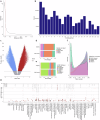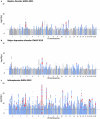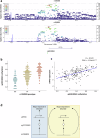Potentially causal associations between placental DNA methylation and schizophrenia and other neuropsychiatric disorders
- PMID: 40087310
- PMCID: PMC11909199
- DOI: 10.1038/s41467-025-57760-3
Potentially causal associations between placental DNA methylation and schizophrenia and other neuropsychiatric disorders
Abstract
Increasing evidence supports the role of the placenta in neurodevelopment and in the onset of neuropsychiatric disorders. Recently, mQTL and iQTL maps have proven useful in understanding relationships between SNPs and GWAS that are not captured by eQTL. In this context, we propose that part of the genetic predisposition to complex neuropsychiatric disorders acts through placental DNA methylation. We construct a public placental cis-mQTL database including 214,830 CpG sites calculated in 368 fetal placenta DNA samples from the INMA project, and run cell type-, gestational age- and sex-imQTL models. We combine these data with summary statistics of GWAS on ten neuropsychiatric disorders using summary-based Mendelian randomization and colocalization. We also evaluate the influence of identified DNA methylation sites on placental gene expression in the RICHS cohort. We find that placental cis-mQTLs are enriched in placenta-specific active chromatin regions, and establish that part of the genetic burden for schizophrenia, bipolar disorder, and major depressive disorder confers risk through placental DNA methylation. The potential causality of several of the observed associations is reinforced by secondary association signals identified in conditional analyses, the involvement of cell type-imQTLs, and the correlation of identified DNA methylation sites with the expression levels of relevant genes in the placenta.
© 2025. The Author(s).
Conflict of interest statement
Competing interests: The authors declare no competing interests.
Figures







Update of
-
Potentially causal associations between placental DNA methylation and schizophrenia and other neuropsychiatric disorders.medRxiv [Preprint]. 2023 Mar 8:2023.03.07.23286905. doi: 10.1101/2023.03.07.23286905. medRxiv. 2023. Update in: Nat Commun. 2025 Mar 14;16(1):2431. doi: 10.1038/s41467-025-57760-3. PMID: 36945560 Free PMC article. Updated. Preprint.
References
-
- Strauss, R. S. Effects of the intrauterine environment on childhood growth. Br. Med. Bull.53, 81–95 (1997). - PubMed
-
- O’Donnell, K., O’Connor, T. G. & Glover, V. Prenatal stress and neurodevelopment of the child: focus on the HPA axis and role of the placenta. Dev. Neurosci.31, 285–292 (2009). - PubMed
MeSH terms
LinkOut - more resources
Full Text Sources
Medical

